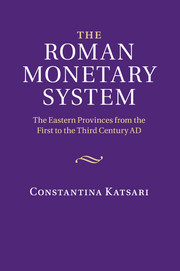Book contents
- Frontmatter
- Contents
- List of charts
- Acknowledgements
- List of abbreviations
- Framing the Roman Monetary System: An Introduction
- 1 Statistics and numismatics
- 2 Planning the financial policy of the Roman state
- 3 Trimetallism and bimetallic laws
- 4 The application of the Quantity Theory of Money to third-century economics
- 5 Roman monetary integration
- 6 Micro-economies
- 7 Metallism vs. chartalism
- Appendix 1 The inscription of Mylasa
- Appendix 2 Excavations finds, coin hoards and museums
- References
- Index
3 - Trimetallism and bimetallic laws
Published online by Cambridge University Press: 01 March 2011
- Frontmatter
- Contents
- List of charts
- Acknowledgements
- List of abbreviations
- Framing the Roman Monetary System: An Introduction
- 1 Statistics and numismatics
- 2 Planning the financial policy of the Roman state
- 3 Trimetallism and bimetallic laws
- 4 The application of the Quantity Theory of Money to third-century economics
- 5 Roman monetary integration
- 6 Micro-economies
- 7 Metallism vs. chartalism
- Appendix 1 The inscription of Mylasa
- Appendix 2 Excavations finds, coin hoards and museums
- References
- Index
Summary
MONETARY STANDARDS
When Augustus established himself as the absolute ruler over the Roman Empire, he quickly realised the need for a stable monetary system across the Mediterranean. However, instead of fashioning an entirely new system, he reinstated the bimetallic standard that his uncle, Julius Caesar, put in place a few years earlier (47–46 BC). The Augustan monetary system was the following:
4 bronze asses = 1 brass sestertius, 15 grains
4 sestertii = 1 silver denarius, about 60 grains
25 denarii = 1 gold aureus, 125 grains
Hence, the ratio between silver and gold was 12:1. The coins were of fine metal; in fact, aurei were struck at forty to the Roman pound, while denarii were struck at eighty-four to the Roman pound. The silver denarius was restored to 97.7–98 per cent fineness until the reign of Nero, while at least until the reign of Galba the aureus remained 98.33 per cent fine. Apart from the main denominations as they are described above, the Roman mints also issued half-aureus and half-denarius pieces, called gold and silver quinarius respectively. Apart from the stabilisation of the monetary system, Augustus was also responsible for the increasing production of lower-denomination coins. Orichalcum was used for the striking of sestertii (25 g) and dupondii (12.5 g) and copper was used for the as (11 g) and its quarter, quadrans (3 g). Despite the use of two different metals, all of these four denominations covered the need for small change in daily transactions.
- Type
- Chapter
- Information
- The Roman Monetary SystemThe Eastern Provinces from the First to the Third Century AD, pp. 72 - 103Publisher: Cambridge University PressPrint publication year: 2011



